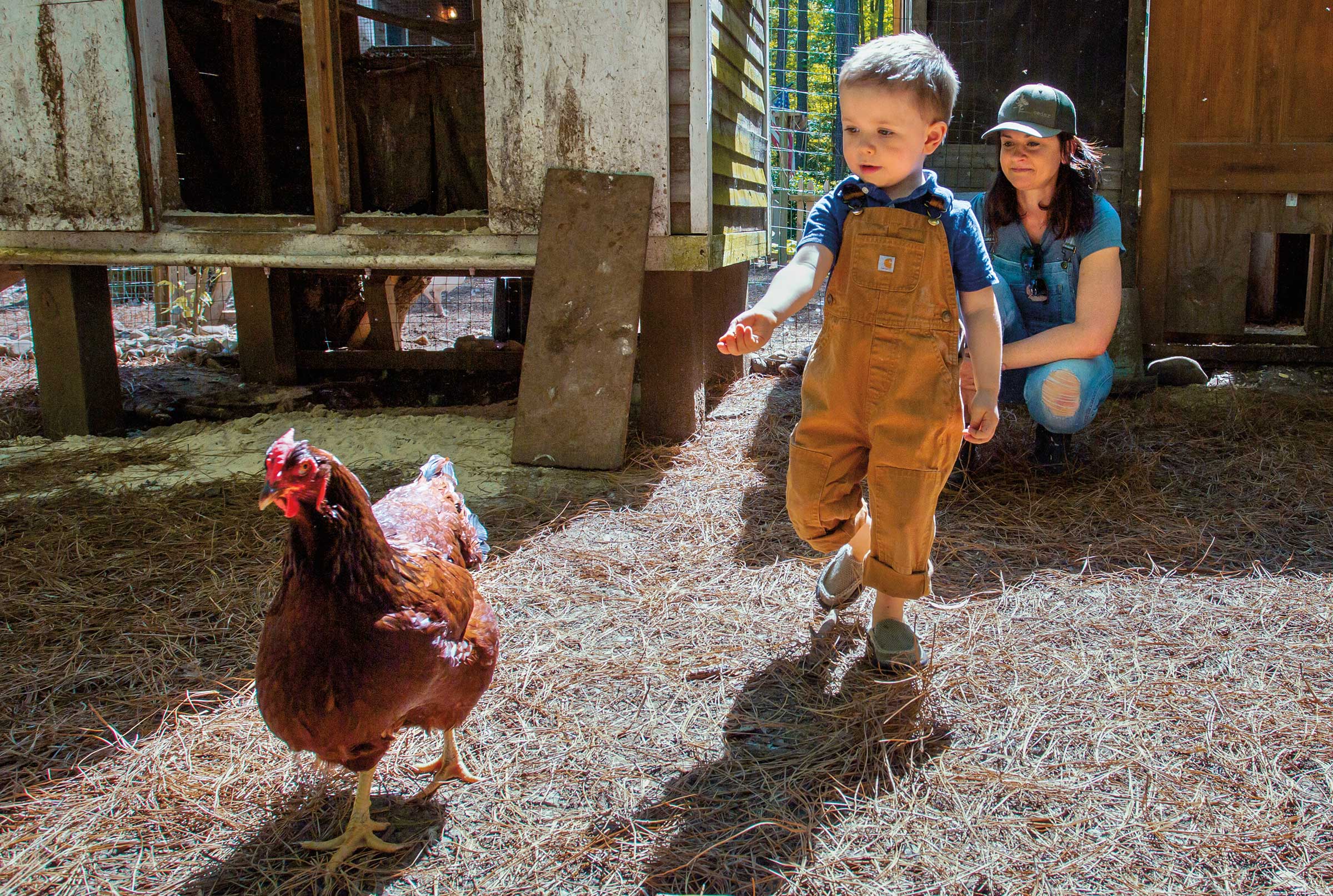
Backyard flocks are flourishing in coastal Sussex, giving eggs and comfort
By Lynn R. Parks | Photographs by Carolyn Watson
From the July 2020 issue

When Joanne Guilfoil was a child, she and her siblings were given three Leghorn chicks by their grandfather. Her mom and dad built a small chicken house in their yard in Westchester County, N.Y., and there the Leghorns, all roosters, stayed.
Until, that is, they were old enough to crow. The racket was too much and the birds were slaughtered. “I think that my mother used them in a curry,” Guilfoil says.
A story like that, tragic as it was for the innocent roosters, could dampen any interest in raising backyard chickens. But for Guilfoil, it was only the beginning. Following the Leghorn incident, her family got Plymouth Rock chickens, this time hens, a flock of which they kept through Guilfoil’s years growing up. And ever since, except her time as an undergraduate at the University of Kentucky, she has had chickens.
Now a Roxana-area resident, Guilfoil has a flock of 14 — 13 hens and one rooster. The birds are mixed-breeds except for two golden Sebrights. Those Sebrights are small (bantams) and lay eggs “the size of ping-pong balls,” Guilfoil says. “You need to eat around three of them to say that you had an egg for breakfast.”
Guilfoil isn’t the only backyard chicken farmer in the First State. About 1,500 Delaware households, 600 of them in Sussex County, have small flocks, most of them egg-laying hens, according to the Delaware Department of Agriculture. (Poultry disease prevention regulations require that the flocks be registered with the state.)
And it’s a growing trend: The number of Delaware backyard flocks has doubled in the last five years, says Department of Ag spokeswoman Stacey Hofmann.
“People enjoy watching their chickens,” says Georgie Cartanza, poultry extension agent with the University of Delaware. “The birds are very entertaining, very social, and have interesting habits.”
“It’s very relaxing, therapeutic even, to watch them out in the yard,” says Kyla Martin, who with her husband, Matt, keeps a flock of nearly two dozen birds on their small farm near Frankford. “They like taking dirt baths and sunbathing, and they make all kinds of interesting noises.”
“My chickens are my pets,” adds John O’Hazza, who has a flock of 22 at his Rehoboth Beach home. “They don’t argue with me, they don’t bother me. They just look to me for food and water and a clean pen.”
Guilfoil considers her chickens pretty and says they respond to her much as dogs do, coming when she calls and going into their small homes for the evening when told to do so. And as if that’s not enough, “they provide food! Every time that I open the door to the nest box and find eggs, it’s like I’m getting a gift.”
Comfort animals
Guilfoil collects about nine eggs every day from her flock. She gives most of them away; those she keeps are used in egg salad and quiches.
“Our eggs are white, light brown, dark brown like chocolate, and greenish,” she says. (The color is determined by the breed of chicken.) “All together, they make for a very nice-looking nest box.”
The Martins gather about 13 eggs, brown, white and green, each day. They too give most of them away; those that they keep are often scrambled, a food that 2-year-old son Cullen loves, his mom says. Kyla also uses them in baking.
The hens in O’Hazza’s flock are aging, and consequently don’t lay as many eggs as they did when young. Piper, born in 2009, doesn’t produce any eggs at all. (Layers can live up to 20 years but typically don’t produce eggs after they are 7.)
“It’s like I’m running a retirement home for hens,” O’Hazza says.
He would like to add new birds to the flock, which at its largest was 40 chickens strong. But he is reluctant to do so following a January change to the Rehoboth Beach code that bans “any cow, goat, sheep, hog, horse or other animal or fowl of any sort” from being kept in the city. The new code exempts from the ban anyone who had chickens at the start of the year, thereby allowing O’Hazza to keep his flock. But even so, “I don’t think that the city wants me to get any more,” he says.
Like Guilfoil, O’Hazza started taking care of chickens as a child. He grew up on what was left of his grandfather’s 100-acre farm in what is now part of Alexandria, Va., and got his first chickens at around 4 years of age. His parents moved to Rehoboth Beach in 1978, O’Hazza followed in 1986, and he and his dad built Sir Guy’s restaurant, which O’Hazza, his cousin Jamie Waple and Waple’s wife, Angela, owned and ran for 13 years. “I didn’t have time for pets then,” he notes.
In 2008, O’Hazza became very sick with pancreatitis. “Both of my parents passed away that same year, and then my dog died,” he says. In response to his illness, he gave up alcohol and cigarettes. And to help himself emotionally, he turned to something that was a source of comfort since childhood.
“Chickens were my therapy,” he says. “Instead of going to Alcoholics Anonymous, I hung out with my hens and they got me through. Even now, I still go out and babble away to them.”
Housing considerations
Despite his good experience, O’Hazza cautions that raising chickens isn’t for everyone. “If you think that you want to take care of chickens, come to my house and clean out the pens one time,” he says. “You will know if it’s for you.”
The key is preparation, advises Lori O’Connell, a small flock educator with the Delaware Department of Agriculture. “Do your research,” she says. “You just can’t go out and buy hens, and put them in your yard. They need food, water and heat, and shelter.”
The biggest challenge in growing backyard flocks is predation, says extension agent Cartanza. Foxes, hawks, even weasels like a taste of fresh chicken now and then, and can decimate a flock. A raccoon got into the chicken enclosure on the Guilfoil farm and killed all but one bird. O’Hazza blames a fox for the 17 dead hens he found one morning, and a hawk for injuring a handsome rooster so badly that O’Hazza had to kill it.
Both O’Hazza and Guilfoil have two houses for their birds. Each house on the O’Hazza property has hens and one rooster in it; the roosters have to be separated to prevent them from fighting, he explains.
The Guilfoil houses are connected by a fenced-in runway to which all the chickens have access. “It looks like a penitentiary back there, with all that fencing,” Guilfoil says.
She also lets her birds out into the yard for about two hours every evening to search through the grass and under leaves for ants, worms and grubs. She sits in the yard with them, watching for predators.
It’s usually no problem getting the birds back into their houses. “When it’s starting to get dark, they become a little nervous and when I stand up, they all look at me like, ‘Now? Is it time to go in?’ And they know that when they go in, they’re going to get a snack of dried worms, so they’re ready.”
Once, though, after a hawk had swooped dangerously close, scaring the birds, two hens fled to shelter under a shed. When Guilfoil put her birds to bed that evening, she didn’t do a head count and missed the fact that the two were absent. Two days later, she saw them creep out from underneath the shed. “They’d been hiding there all that time and were soaking wet,” she says. “I opened the door to their house and they went right in. And all the other hens immediately starting yakking to them, asking them where they’d been and what they’d been doing.”
Chickens on the Martin farm used to have the run of the yard. But after Cullen started toddling around, and also had the run of the yard, the chickens had to be confined to their two houses and a connecting run. Even so, they have about three-quarters of an acre in which to roam and lay their eggs. “We find eggs all over, in spots where the chickens have hidden them,” Martin says.
One of the Martin hens, a Rhode Island Red, likes to brood, or sit on eggs so that (if they have been fertilized by a rooster) they hatch. “We let that happen sometimes,” Martin says. “But if we let it always happen, we’d be overrun with chickens.”
Like O’Hazza and Guilfoil, Martin had chickens as a child and recommends raising poultry as a family activity. “It’s a really cool thing to do together,” she says. “It gets you outside, and for children, it teaches responsibility and things about life that can be hard” — like the ways of foxes and hawks.
“Kids today need something to take care of,” says Guilfoil. “Caring for another living thing is so much responsibility. Do they have water? Do they have food? There is a lot of good learning that can happen.”
She’s not sure she would be a chicken farmer today if her family hadn’t had birds when she was young. But without her hens, life would be very boring, she adds.
“I don’t know why my grandfather decided to get us those three chicks all those years ago,” Guilfoil says. “But I’m sure glad that he did.”



